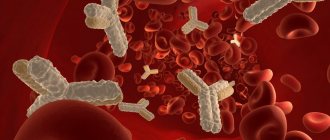The pancreas is a vital organ in the human body. Nature has assigned it the function of secreting enzymes for the digestive process. The ducts of the gland transport enzymes through the duodenum to the small intestine, where the digestion process occurs. There, under the influence of enzymes, proteins, fats and carbohydrates received during meals are broken down and absorbed. One of the enzymes is diastase, secreted by the pancreas and parotid glands. It breaks down starches into oligosaccharides, and other enzymes bring the breakdown process to the state of glucose, without which it is impossible to replenish energy in the body. In order to identify pathologies in the human body, they take a test for diastase in the blood.
What is diastasis
Diastase breaks down carbohydrates into sugars
Diastase, otherwise called alpha-amylase, refers to one of the main digestive enzymes secreted by the pancreas.
The function of diastase is to break down carbohydrates into sugars for their further absorption in the body.
In healthy people, when the gland cells are intact, the concentration of diastase in the blood is normal, but in some patients there may be an increase or decrease in the index.
To diagnose diseases in medicine, they resort to a biochemical blood test to determine the concentration of diastase, since an increase or decrease in it may indicate serious pathologies in the body.
What do deviations in the analysis indicate?
Although the content of this enzyme primarily gives the doctor information about the pancreas, the results of the analysis can partially judge the functioning of the kidneys or bladder. Sometimes there is a need to conduct additional tests to clarify the suspected diagnosis.
Low urine amylase levels
If amylase S levels are low, this indicates:
- liver cirrhosis;
- intoxication of the body for various reasons;
- chronic kidney disease.
High urine amylase levels
If the test reveals too high levels of the amylase P enzyme, this may indicate the following:
Diastase norm for children and adults
The diastase index varies depending on the age of the person. For men and women, the concentration of this enzyme makes no difference, it is the same.
The standards should be:
- for newborns, a fluctuation within 8 units/l is considered;
- in children from one year to 10 years, the normal level of diastase is approximately 30 units/l;
- the age period from 10 to 18 years should have an enzyme concentration in the blood of no more than 40 units/l;
- in elderly people under 70 years of age, the diastase index should be 125 U/L;
- for people over 70, the normal level is approximately 160 units/l.
An increase and decrease in the diastase index in the blood indicates pathological changes in digestion.
Treatment of abnormalities
Although the content of this substance in urine mainly provides information about the pancreas, an imbalance of this enzyme can be useful in studying the condition of other human organs and systems. Additional tests may be required to clarify the doctor's conclusions.
If the analysis shows that the amylase content in urine is not normal, you need to consult a doctor. So that he can determine the cause of the existing violations. Based on the diagnosis, the most effective treatment will be proposed.
Why does the diastase index increase?
An increased concentration of diastase in the blood indicates pathologies in the functioning of internal organs
If test results show an increased concentration of diastase in the blood, then this is a likelihood of pathologies in the functioning of internal organs. What are the reasons for the increase? This is observed:
- In acute and chronic pancreatitis, when an inflammatory process occurs in the tissues of the gland, the level of diastase increases.
- The presence of a cyst or stone blocks the lumen in the pancreatic ducts. In this case, the structure of this organ changes, the tissue of the gland is compressed, and this leads to secondary inflammation. The secretion of diastase increases.
- In the presence of a cancerous tumor in the tissues of the gland or in the head of this organ, an increase in the production of the enzyme diastase is also observed.
- With cholecystitis (inflammation of the bile ducts) and cholelithiasis, if stones migrate in the bile ducts, they close the lumen in the passages. As a result, the level of diastase increases.
- Acute peritonitis - an inflammatory process in the abdominal cavity increases the activity of gland cells. These changes are accompanied by an increase in diastase concentration.
- In the presence of renal failure, a change in the diastase index is observed. Since the enzyme is excreted through the kidneys in the urine, insufficient excretory function can lead to retention of secretions in the body and its increase.
- With mumps of an epidemic nature, inflammation of the parotid salivary glands, the secretion of amylase (diastase) also increases.
- Diabetes mellitus also causes an increase in diastase in the blood. With this disease, the metabolism in the patient’s body is completely disrupted, which concerns, first of all, carbohydrate metabolism. Since the gland enzyme will not be rationally consumed in the process of breaking down starches into oligosaccharides, it will accumulate, therefore, the level of diastase will be increased.
There are medications, the use of which increases the concentration of diastase in the blood. These include:
painkillers with narcotic content;
- aspirin;
- antibiotics;
- drugs used in the treatment of tumors;
- preparations containing gold.
Drugs such as heroin and cocaine increase the level of diastase. In those who take drugs, the concentration of diastase will be constantly elevated.
Possible ailments with high and low amylase
This analysis can be a significant sign of the presence of various diseases.
Pathologies in pregnant women
If a woman is carrying a child, pathology in the amylase content may indicate the following:
- Acute form of pancreatitis.
- Viral mumps.
- Presence of peritonitis.
- The possibility of an ectopic pregnancy.
- This anomaly is sometimes a sign of rupture of the fallopian tubes.
Recommended video:
Childhood diseases and diastase levels
In childhood, situations are especially dangerous when the content of this enzyme in the urine is underestimated. In this case we can talk about:
- pancreatitis;
- renal failure;
- possibility of appendicitis.
It may also be a sign of other serious illnesses. Additional tests may be required to clarify the diagnosis.
Pancreatic diseases and amylase
In acute pancreatitis, an increased amount of amylase is produced. If a patient has chronic pancreatitis, then the level of this enzyme in urine increases when exacerbations of the disease occur.
Elevated levels of the enzyme appear almost at the very beginning of the attack. After approximately four to six hours have passed, it will reach its maximum. After this, the concentration of the substance will decline. During an attack, the excess of the norm can occur 8 - 10 times.
During exacerbation of chronic pancreatitis, a similar situation occurs, but the excess of the enzyme in urine is less than in the previous case. In this case, the level increases by 2 - 3 times.
The analysis may indicate other disorders in this organ. For example, we can talk about stones, pseudocysts, neoplasms or tumors in this organ.
How is diastase testing performed?
To get a reliable analysis result, you need to prepare for the study
To get the correct analysis result, you should prepare for the procedure with all seriousness:
- The analysis requires a venous blood sample, which must be taken in the morning on an empty stomach.
- 4-5 days before donating blood, fatty and fried foods are not recommended.
- The day before the laboratory test, the patient should not drink alcohol.
- Smoking is prohibited approximately 4 hours before blood collection.
- You should not take medications on the eve of the tests; if you do take them, you must notify your doctor.
If these simple rules are not followed, the analysis results may be incorrect.
How to remove diastasis
The treatment regimen for the pathology depends on the stage of its development and the degree of manifestation. At the first stage, it is enough to follow the doctor’s recommendations, which will help strengthen the muscles of the abdominal wall and reduce their discrepancy:
- reduce weight to normal levels;
- maintain a balanced diet with limited consumption of fatty and sweet foods;
- adhere to the daily fluid intake;
- wear a bandage that supports the stomach;
- undergo massage and other physical procedures;
- do swimming, yoga, Pilates or physical therapy.
Physical therapy should be carried out under the supervision of a specialist. He creates a program with the correct load level. Particular attention is paid to the deep transverse and oblique abdominal muscles, which, with an appropriate level of tone, reduce the degree of stretching of the linea alba.
A set of therapeutic exercises is useful even for pregnant women. With its help, you can prevent the development of pathology and speed up the process of postpartum recovery of the body.
Such training takes place without straining the abdominal muscles. It is also not recommended to do exercises while standing, including on your knees or elbows. Such loads are permissible only after restoration of the normal width of the lumen.
In later stages, the discrepancy can no longer be corrected with exercise or massage. Surgical intervention is necessary to return the muscle corset to its place and relieve complications and symptoms. It could be:
- Tensionplasty using patient tissue. The surgeon removes excess connective tissue and stitches the edges of the muscles together. This method is the least preferable, since relapses occur quite often after it.
- Tension plastic using a prosthesis. It involves the same removal of excess tissue and suturing of muscle layers, but is accompanied by additional strengthening using a mesh polypropylene prosthesis.
- Tension-free plastic surgery with installation of a prosthesis. An endoprosthesis is inserted under the stretched area, which serves as a barrier and replaces the weakened structures.
- Combined approach. It involves a combination of tension and non-tension plastic surgery.
The specialist selects the surgical method taking into account the characteristics and degree of development of the pathology, as well as individual factors and the patient’s health status. Full recovery after the intervention occurs within 1 to 3 months. At this time, it is necessary to avoid excess tension, adhere to a diet and wear a special bandage that relieves stress from the operated muscle structures.
Indications for the test
In modern clinical practice, a specialized doctor can prescribe one of two types of tests for the specific enzyme described above, detected in the urn and blood. In the first case, it is called an analysis for diastase, in the second - for amylase in the alpha-base modification. Most often, a diastase test is prescribed for suspected:
- Various chronic infections;
- Having diabetes mellitus type 1 or 2;
- The presence of pathologies of the pancreas;
- Traumatic injuries to internal organs in the gastrointestinal tract;
- Regular disruptions in the gastrointestinal tract;
- Local lesions of the ear and salivary glands.
It should be understood that a specialized specialist can prescribe an analysis for diastasis in other situations, when there is a suspicion that the identified disease has provoked the development of complications and secondary dysfunction of the pancreas.
Preparing for analysis
From a technical point of view, the procedure for preparing for the study itself does not require any specific skills. However, to increase the objectivity and reliability of the results, doctors insist on compliance with the necessary conditions.
These simple rules include:
- The study of the enzyme is carried out after a twelve-hour break in food intake.
- Drinking any alcoholic beverages is unacceptable within 24 hours before urine collection.
- To ensure a stylish container for collecting biological material, it is advisable to wash it with baking soda, rinse thoroughly, pour boiling water over it or hold it over steam.
- Follow the rules for urine collection established in this laboratory. For some types of laboratory testing, the biological sample is delivered warm within two hours.
The reliability of the study may be affected by the patient's medication intake. The patient is obliged to warn about this in advance.
These include:
- Antibiotics from the tetracycline group: Doxycycline, Metacycline, Glycocycline, Morphocycline, Oletetrin, Olemorphocycline.
- Dosage forms that contain adrenaline: Brilocaine-adrenaline, Brilocaine-adrenaline forte, Xylocaine adrenaline, Xyloroland with adrenaline, Lidocaine-adrenaline.
- Analgesics with narcotic components: Buprenorphine, Lixir, Pentazocine, Butorphanol, Tramal, Delarin, Naloxone.
- Non-steroidal anti-inflammatory drugs: Salasat, Diflunisal, Diflofenac, Ketorolac, Sulindac, Indomethacin.
- Preparations using gold: Crizanol, Tauredon 50, Sodium aurothiomalate, Aurothioglucose.
Doctors include subjective factors that can distort the diagnostic picture of the study:
- Pregnancy at an early stage. In women, this circumstance can significantly affect the result of the examination. Therefore, the patient should warn the medical staff about this.
- Asthmatic attacks.
- Colds and diseases aggravated by various infections, with obvious symptoms - cough.
Knowing how to collect urine for diastase, you can be completely confident in the authenticity of the results obtained. To do this, remember the following recommendations:
- Do not drink alcoholic beverages for 24 hours before the test.
- When taking medications, ask your doctor if you can continue treatment or if it is better to stop it for a while. The fact is that some groups of drugs, as mentioned earlier, can significantly influence the results of studies.
- To collect urine, you must use either a sterilized glass jar or a special container, which can be purchased at almost every pharmacy.
- Before you start collecting urine, talk to your doctor. You may have to give your urine directly at the clinic.
Based on what urine diastasis is and what effect its level has on the functioning of all organs and systems in the human body, we can draw a clear conclusion: if you monitor your health and regularly undergo medical examinations just for prevention, you will not miss the moment development of severe pathology.










